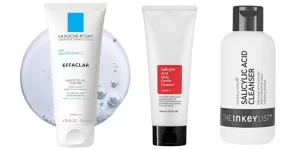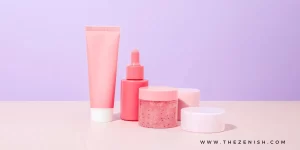
Have you ever woken up and noticed a little (or massive) pimple on your temple? It’s not the most convenient location for a breakout, is it?
But did you know that pimples on your temples can actually indicate something about your overall health?
Understanding the meaning behind these inconvenient pimples can help you take better care of yourself and even prevent future breakouts.

So, let’s dive in and learn more about pimples on temples meaning, causes, significance, and the best ways to prevent them.
Why am I breaking out at my temples?
When you notice pimples on your temples, it’s natural to wonder what might be causing them.
They can be attributed to various factors, ranging from poor hygiene to hormonal changes.
Understanding the underlying causes can give you a better sense of how to address them and prevent them from recurring.
Hair products and hats
One possible cause of acne on your temples or forehead is the use of certain hair products, which may lead to a condition called pomade acne.
Forehead acne can be related to the use of hair products such as pomades, gels, and sprays, especially if they are oil-based, as these products can clog your pores and lead to acne breakouts.
Aside from hair products, if you regularly wear hats or headgear, friction between the fabric and your skin might also be contributing to your breakouts.
Wearing hats or other headgear can also contribute to acne by trapping sweat and oil, which then clogs your pores. When you wear a hat or other headgear, ensure it is clean, breathable, and not too tight to minimize the chances of developing breakouts.
Hormones and hormonal imbalance
Hormonal changes can also be a significant factor in the development of temple acne.
Fluctuations in your hormone levels, especially during puberty, menstrual cycles, or pregnancy, may trigger acne breakouts on your temples.
Certain medications, like corticosteroids, can also cause hormonal imbalance, leading to temple acne.
What causes hormonal acne: 5 signs you’re dealing with it.
Clogged pores and oil production
Another major factor that contributes to temple acne is clogged pores. Dirt, oil, and dead skin cells can accumulate in your pores, leading to inflammation and the formation of pimples.
When your sebaceous glands produce excess sebum (the oily substance that keeps your skin moisturized), it can further increase your risk of developing acne.
During times of hormonal fluctuation, such as puberty or menstruation, your oil glands may be more active, making you more prone to breakouts around your temples as well as other areas like your nose, cheeks, jawline, chin, hairline, and forehead.
So, if you’re experiencing pimples on your temples, it could be due to hormones wreaking havoc on your skin. Don’t worry, we’ve all been there!
5 Best Products To Unclog Clogged Pores
Makeup
Using makeup, particularly oil-based or heavy formulations, can also cause temple acne.
Makeup products that are not non-comedogenic can clog your pores and lead to pimples. So whenever possible it’s important to choose makeup that’s non-comedogenic and suited to your skin type.
Additionally, not thoroughly removing makeup before going to bed at night can contribute to acne as it allows makeup to mix with oil and dirt, further clogging your pores overnight.
Skincare products
We all love trying out new lotions and potions, but sometimes your skin doesn’t agree with them.
Certain skincare products can contain ingredients that can irritate our skin and lead to breakouts, especially on your temples where the skin is more sensitive.
So, if you’re trying out a new product and notice pimples on your temples, or areas where you don’t typically get breakouts, it could be worth taking a closer look at the ingredients list.
Stick to products that are non-comedogenic (meaning they won’t clog your pores) and free of harsh chemicals or oils, and your skin will thank you.
Cell phone and pillow habits
Your cell phone and pillow can also play a role in causing temple acne. Regularly touching your cell phone to your temple while talking can transfer bacteria and oils from the screen to your skin, which can cause acne.
Similarly, your pillowcase can harbour oils, sweat, and bacteria from your face and product residue from your hair, which can cause you to break out if they’re not regularly washed or sanitized.
To help reduce the risk of temple acne, sanitize your phone regularly, try using headphones or speakerphone when talking and regularly wash your pillowcase to minimize the buildup of oils and bacteria.
Allergies
Did you know that allergies can also cause pimples on your temples?
It’s true!
If your body has an allergic reaction, it can cause inflammation and irritation in your skin, leading to breakouts.
Allergies to certain foods or environmental factors, such as pollen or dust, can be the culprit.
So, if you notice that the pimples on your temples coincide with allergy season or after eating certain foods, it could be worth investigating if allergies are the cause.
Maybe it’s time to try out some allergy medication or switch up your diet.
Other causes
Face mapping is an ancient traditional Chinese medicinal practice that suggests that the location of facial acne corresponds to specific organs within your body – in this case, your kidneys and bladder.
Face mapping links the location of your acne to various causes, such as diet, hormones, and stress. And according to Ayurvedic interpretation, pimples on the temples might signify an imbalance in your body’s Kapha dosha, which is responsible for oil stabilization in the skin.
Ensuring your diet and lifestyle choices balance, your Kapha dosha may help improve temple acne.
If that’s the case, you may want to monitor your consumption of alcohol and heavily processed or greasy foods.
| this post may contain affiliate links, which means if you purchase from one of these links, I may receive a small commission at no additional cost to you. |
Treatment options and prevention strategies
Alright, now that you know what can cause pimples on your temples, let’s talk about how to treat and prevent them.
Home remedies
First up, we have home remedies! Yup, sometimes the simplest solutions are the most effective.
Proper hygiene is key in preventing pimples on your temples, so make sure you’re washing your face at least once a day (preferably at the end of the day before bed) with a gentle cleanser.
You can also try using natural remedies, such as tea tree oil or aloe vera, to help soothe any inflammation and reduce redness. Natural remedies can sometimes be a great alternative to products and can be gentle on your skin.
Over-the-counter acne treatments
Sometimes, home remedies aren’t enough, and that’s where medical treatments come in.
For treating acne on your temples, start by exploring over-the-counter acne treatments.
These products usually contain ingredients like salicylic acid or benzoyl peroxide, which can help unclog your pores and reduce inflammation.
Apply these treatments directly to the affected areas as instructed on the product packaging. And remember to be patient, because it may take a few weeks to see any significant improvements.
Prescription medications and dermatologist recommendations
If over-the-counter treatments aren’t giving you the desired results, consider consulting a dermatologist. He or she may recommend prescription medications such as topical retinoids or oral antibiotics.
Topical retinoids are particularly effective for addressing moderate to severe acne by increasing your cell’s turnover rate, thus unclogging your pores.
Oral antibiotics can be prescribed to treat any bacterial infections causing your acne. However, keep in mind that results may take four to eight weeks to appear, and it may take months or even years for your acne to completely clear up.
7 Awesome products for treating pimples on your temples
Here are 7 skincare products that may help treat acne on your temples:
#1
Sunday Riley UFO Ultra-Clarifying Face Oil
This face oil contains 1.5% salicylic acid to help unclog pores and reduce inflammation, along with tea tree oil and chamomile to soothe and calm the skin. It is priced at around $40-80.
#2
Drunk Elephant T.L.C. Sukari Babyfacial
This exfoliating mask contains a blend of alpha and beta hydroxy acids to help remove dead skin cells and unclog pores, along with antioxidants to brighten and improve the texture of the skin. It is priced at around $80.
#3
La Roche-Posay Effaclar Duo Dual Action Acne Treatment
This spot treatment contains 5.5% benzoyl peroxide to help kill acne-causing bacteria and reduce inflammation, along with glycerin to hydrate and soothe the skin. It is priced at around $30-40.
#4
iS Clinical Cleansing Complex
This cleanser contains a blend of salicylic acid, antioxidants, and hydrating ingredients to help remove impurities without stripping the skin of its natural oils.
#5
SkinCeuticals Phloretin CF Serum
This antioxidant serum contains a blend of phloretin, vitamin C, and ferulic acid to protect the skin from environmental damage and improve the appearance of discoloration and acne scars. It is priced at around $170-200.
#6
Murad Clarifying Mask
This mask contains kaolin clay and sulphur to help draw out impurities and reduce inflammation, along with licorice extract to soothe and calm the skin. It is priced at around $40-50.
#7
Kiehl’s Clearly Corrective Dark Spot Solution
This serum contains a blend of vitamin C, white birch extract, and peony extract to brighten the skin and improve the appearance of dark spots and acne scars. It is priced at around $60-80.
Pimples on temples meaning: different types of acne that might show up on your temples
Everyone’s skin is unique, and so is their experience with acne.
But let’s discuss different types of acne that you may encounter, focusing on three main sub-categories: whiteheads and blackheads, red bumps and inflammation, and scarring and redness.
Whiteheads and blackheads
Whiteheads and blackheads are both common types of acne that can appear on your temples, as well as other areas of your face.
They both form when pores become clogged with excess oil, dead skin cells, and bacteria. The difference between them lies in whether the pore is open or closed.
Whiteheads are closed comedones, meaning the pore is sealed, which creates a small white bump on the skin’s surface.
Blackheads, on the other hand, are open comedones. The pore remains open, and the clogged material darkens as it reacts with the air, creating a black or dark-colored spot.
Red bumps and inflammation
Beyond whiteheads and blackheads, you may also experience red, inflamed acne types like papules and pustules.
Papules are small, raised red bumps that can be tender to the touch. This occurs when the clogged pore walls start to break down, causing inflammation.
Pustules take it a step further, filling with pus as your body fights off the bacteria.
They typically have a white or yellow center and can be tempting to pop, but it’s essential to resist the urge, as this can potentially worsen the pimple and cause scarring.
Scarring and redness
Sometimes, acne can leave behind scars or redness, even after the pimple has healed. The severity of scarring depends on your skin type, how you treated the acne, and whether or not you picked at it.
One way to minimize scarring and redness is by practicing good skincare habits, like keeping your skin clean and moisturized, avoiding the urge to pick or pop at your pimples, and seeking professional advice from a dermatologist when needed.
Now that you are more familiar with the different types of acne and how they might manifest on your temples, you can better understand your skin’s unique needs and work toward healthier, clearer skin.
Health problems pimples on your temples can indicate
Okay, so pimples on your temples might not just be a skin issue, but could also be indicating an underlying health issue.
#1: Hormonal imbalance
Hormonal imbalances, such as polycystic ovary syndrome (PCOS), can lead to pimples on your temples due to an increase in sebum production.
#2: Digestive problem
Digestive problems, like a poor diet or gut imbalances, can also show up on your skin in the form of pimples.
#3: Immune system disorder
And immune system disorders, such as lupus or psoriasis, can cause inflammation in your skin and lead to breakouts.
So, if you’re noticing persistent pimples on your temples, it could be worth talking to your doctor to rule out any underlying health issues.
Lifestyle changes and skincare routines
Maintaining a proper skincare routine is essential for preventing and treating acne on your temples.
- Start by washing your face twice a day with a mild facial cleanser and lukewarm water.
- Avoid scrubbing or applying harsh pressure, which may further irritate your skin.
In addition to a proper skincare routine, make some lifestyle changes to reduce acne flare-ups.
- Avoid touching your face and keep your hair off your forehead and temples to prevent any excess oil from clogging your pores.
- Also, keep an eye on your hair and skincare products; some products can be comedogenic, meaning they can clog your pores and contribute to acne problems.
- You may need to switch to non-comedogenic products if you’re experiencing regular breakouts on your temples.
And consult a dermatologist for personalized advice, especially if you’re experiencing severe or persistent acne.



